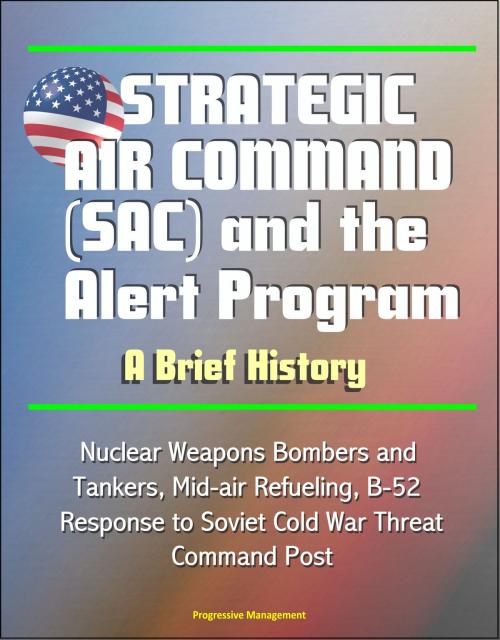Strategic Air Command (SAC) and the Alert Program: A Brief History - Nuclear Weapons Bombers and Tankers, Mid-air Refueling, B-52, Response to Soviet Cold War Threat, Command Post
Nonfiction, History, Military, Nuclear Warfare, Aviation| Author: | Progressive Management | ISBN: | 9781310322839 |
| Publisher: | Progressive Management | Publication: | September 21, 2014 |
| Imprint: | Smashwords Edition | Language: | English |
| Author: | Progressive Management |
| ISBN: | 9781310322839 |
| Publisher: | Progressive Management |
| Publication: | September 21, 2014 |
| Imprint: | Smashwords Edition |
| Language: | English |
This illustrated history of the SAC Alert Force documents the efforts of thousands of dedicated aircrews, missileers, maintenance specialists, and support personnel who worked diligently to give the nation a credible deterrent force during the cold war.
Throughout most of its first decade, Strategic Air Command operated from safe sanctuaries located in the United States. This situation began to change in the mid-1950s as the Soviet Union began to build up its long-range bomber force and to develop intercontinental ballistic missiles. Defense planners saw these actions as a conscious effort to project Soviet military power worldwide and to place the United States under the direct threat of nuclear attack. Given the inferiority of Soviet forces to those of the United States, it seemed reasonable to SAC planners that, in the event of war, the Soviets would employ a basic military stratagem to quickly gain superiority, that of surprise.
The threats posed by growing Soviet forces and surprise attack demanded immediate attention. Planners at Headquarters Strategic Air Command understood the necessity of an immediate retaliatory response to Soviet aggression. They also knew that to respond effectively, they had to protect the strategic force from surprise destruction on the ground. Their concerns produced extensive studies aimed at neutralizing the threat of surprise attack, assuring a meaningful SAC response, and making the Soviets uncertain of success.
SAC planners devised the alert program to safeguard nuclear deterrence. They proposed to keep SAC's bombers and tankers on alert with weapons loaded and crews ready for immediate takeoff. Their goal was to place one-third of the command's aircraft on ground alert at all times. The one-third figure was dictated by training, manpower, and logistical requirements.
Having formulated the alert concept, the command next undertook three tests to determine Its feasibility. The 39th Air Division at Hunter AFB, Georgia, conducted the first test, Operation Try Out, from November 1956 to March 1957. This effort proved that ground alert was feasible. Two additional tests worked out problems identified in Operation Try Out and perfected the alert concept. The second test, Operation Watch Tower, was performed by the 825th Air Division at Little Rock AFB, Arkansas, between April and November 1957- The last test, Operation Fresh Approach, fell to the 9th Bombardment Wing at Mountain Home AFB, Idaho, in September 1957.
This illustrated history of the SAC Alert Force documents the efforts of thousands of dedicated aircrews, missileers, maintenance specialists, and support personnel who worked diligently to give the nation a credible deterrent force during the cold war.
Throughout most of its first decade, Strategic Air Command operated from safe sanctuaries located in the United States. This situation began to change in the mid-1950s as the Soviet Union began to build up its long-range bomber force and to develop intercontinental ballistic missiles. Defense planners saw these actions as a conscious effort to project Soviet military power worldwide and to place the United States under the direct threat of nuclear attack. Given the inferiority of Soviet forces to those of the United States, it seemed reasonable to SAC planners that, in the event of war, the Soviets would employ a basic military stratagem to quickly gain superiority, that of surprise.
The threats posed by growing Soviet forces and surprise attack demanded immediate attention. Planners at Headquarters Strategic Air Command understood the necessity of an immediate retaliatory response to Soviet aggression. They also knew that to respond effectively, they had to protect the strategic force from surprise destruction on the ground. Their concerns produced extensive studies aimed at neutralizing the threat of surprise attack, assuring a meaningful SAC response, and making the Soviets uncertain of success.
SAC planners devised the alert program to safeguard nuclear deterrence. They proposed to keep SAC's bombers and tankers on alert with weapons loaded and crews ready for immediate takeoff. Their goal was to place one-third of the command's aircraft on ground alert at all times. The one-third figure was dictated by training, manpower, and logistical requirements.
Having formulated the alert concept, the command next undertook three tests to determine Its feasibility. The 39th Air Division at Hunter AFB, Georgia, conducted the first test, Operation Try Out, from November 1956 to March 1957. This effort proved that ground alert was feasible. Two additional tests worked out problems identified in Operation Try Out and perfected the alert concept. The second test, Operation Watch Tower, was performed by the 825th Air Division at Little Rock AFB, Arkansas, between April and November 1957- The last test, Operation Fresh Approach, fell to the 9th Bombardment Wing at Mountain Home AFB, Idaho, in September 1957.















